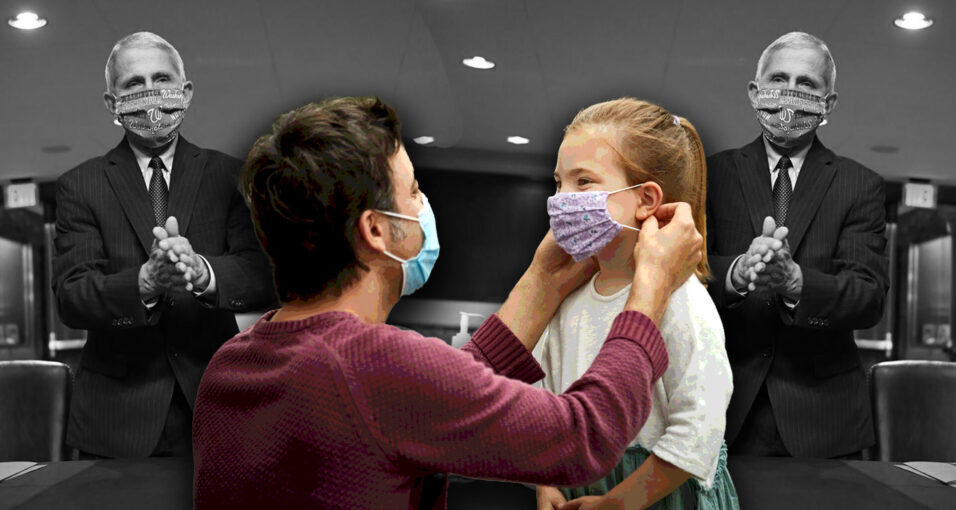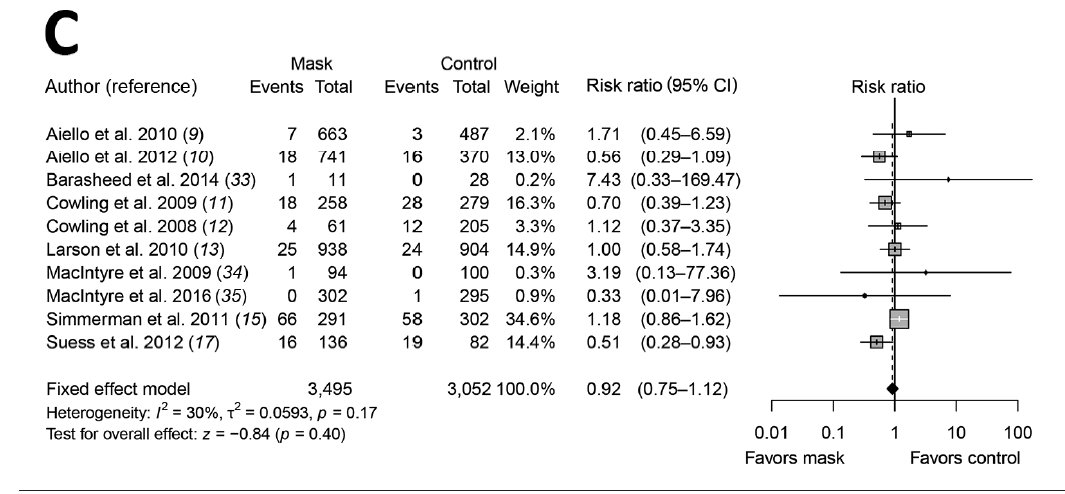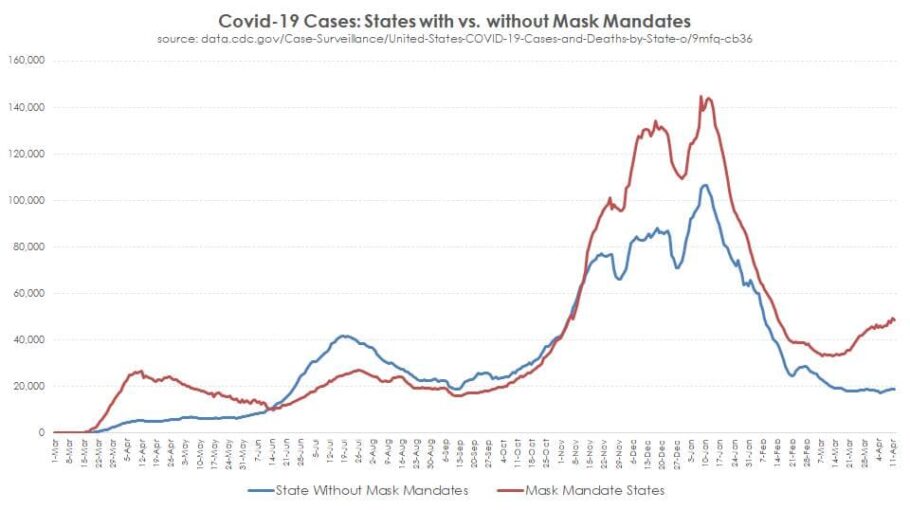The main study that media outlets and the government used to prove that surgical masks are effective has just completely fallen apart.

In the initially published piece, the authors did not post the raw number of seropositive cases in their study, preventing anyone from computing standard statistical analyses of their results. Many experts also objected to the number of statistical regressions run to pull signals out of their very complex intervention.
Recently, the authors finally released their code and data.
The famous Bangladesh study that supposedly proves surgical masks (not cloth masks) works has absolute difference of 20 symptomatic cases over 8 weeks.
Wow! What a sham. https://t.co/UYRr8a1LdN
— Aaron Ginn (@aginnt) November 24, 2021
Following the release of their data, statistical analyses were able to be conducted. There were 1,106 symptomatic individuals confirmed seropositive in the control group and 1,086 such individuals in the treatment group. The total difference between the two groups was miniscule: only 20 cases out of over 340,000 individuals over a span of 8 weeks.
In a post by one author who ran an analysis following the release of the data, he described several other issues with the study:
“The intervention was highly complex and included a mask promotion campaign and education about other mitigation measures including social distancing. Moreover, individuals were only added to the study if they consented to allow the researchers to visit and survey their households.
“There was a large differential between the control and treatment groups here, with 95% consenting in the treatment group but only 92% consenting in control. This differential alone could wash away the difference in observed cases. Finally, symptomatic seropositivity is a crude measure of covid as the individuals could have been infected before the trial began.”
The CDC Caught Hiding Data About Mask Efficacy in Schools
According to a recent report in NY Magazine, the CDC covered up what one of their own studies found about masking children in schools.
The Centers for Disease Control and Prevention published a notable, yet mostly ignored, large-scale study of COVID transmission in American schools at the end of May.
The findings in their study cast doubt on the impact of things like distancing, hybrid models, classroom barriers, HEPA filters, and, most notably, requiring student masking.
In the CDC’s study, they found no statistically significant benefit to any of these. In other words, “these measures could not be said to be effective.”
Despite the findings in their own study, the CDC a month later recommended that all kids starting at the age of 2 wear masks regardless of vaccination status.
The Vast Majority of Scientific Research Show Masks are Ineffective at Preventing the Spread of Respiratory Illnesses
The randomized clinical trial (RCT) is recognized as the most credible research design for clinical investigation. The goal of the RCT is to achieve a valid comparison of the effects of an investigational treatment or treatments with the control treatment (standard of care) in the target patient population.
Contrary to popular belief, every single RCT ever performed on mask usage and prevention of infection for laboratory-confirmed influenza, the common cold, or other respiratory viruses shows that masks are ineffective.
The CDC recently even conceded that they are not aware of any randomized control trials that conclude masks are effective at preventing the spread of coronavirus, or any respiratory virus for that matter.
2) Per the CDC, there is no known study showing masks help stop the spread of Covid pic.twitter.com/aqBW9Men7j
— Tom Elliott (@tomselliott) September 9, 2021
Jacobs, J. L. et al. (2009) “Use of surgical face masks to reduce the incidence of the common cold among health care workers in Japan: A randomized controlled trial,” American Journal of Infection Control, Volume 37, Issue 5, 417–419.
N95-masked healthcare workers (HCW) were significantly more likely to experience headaches. Face mask use in HCW was not demonstrated to provide benefit in terms of cold symptoms or getting colds.
Radonovich, L.J. et al. (2019) “N95 Respirators vs Medical Masks for Preventing Influenza Among Health Care Personnel: A Randomized Clinical Trial,” JAMA. 2019; 322(9): 824–833.
“Among 2862 randomized participants, 2371 completed the study and accounted for 5180 HCW-seasons. … Among outpatient health care personnel, N95 respirators vs medical masks as worn by participants in this trial resulted in no significant difference in the incidence of laboratory-confirmed influenza.”
Long, Y. et al. (2020) “Effectiveness of N95 respirators versus surgical masks against influenza: A systematic review and meta-analysis,” J Evid Based Med. 2020; 1–9.
“A total of six RCTs involving 9,171 participants were included. There were no statistically significant differences in preventing laboratory-confirmed influenza, laboratory-confirmed respiratory viral infections, laboratory-confirmed respiratory infection, and influenza-like illness using N95 respirators and surgical masks. Meta-analysis indicated a protective effect of N95 respirators against laboratory-confirmed bacterial colonization (RR = 0.58, 95% CI 0.43-0.78). The use of N95 respirators compared with surgical masks is not associated with a lower risk of laboratory-confirmed influenza.”
Cowling, B. et al. (2010) “Face masks to prevent transmission of influenza virus: A systematic review,” Epidemiology and Infection, 138(4), 449-456.
None of the studies reviewed showed a benefit from wearing a mask, in either HCW or community members in households (H). See summary Tables 1 and 2 therein.
Bin-Reza et al. (2012) “The use of masks and respirators to prevent transmission of influenza: a systematic review of the scientific evidence,” Influenza and Other Respiratory Viruses 6(4), 257–267.
“There were 17 eligible studies. … None of the studies established a conclusive relationship between mask/respirator use and protection against influenza infection.”
Smith, J.D. et al. (2016) “Effectiveness of N95 respirators versus surgical masks in protecting health care workers from acute respiratory infection: a systematic review and meta-analysis,” CMAJ Mar 2016
“We identified six clinical studies … . In the meta-analysis of the clinical studies, we found no significant difference between N95 respirators and surgical masks in associated risk of (a) laboratory-confirmed respiratory infection, (b) influenza-like illness, or (c) reported work-place absenteeism.”
Offeddu, V. et al. (2017) “Effectiveness of Masks and Respirators Against Respiratory Infections in Healthcare Workers: A Systematic Review and Meta-Analysis,” Clinical Infectious Diseases, Volume 65, Issue 11, 1 December 2017, pages 1934–1942,
“Self-reported assessment of clinical outcomes was prone to bias. Evidence of a protective effect of masks or respirators against verified respiratory infection (VRI) was not statistically significant.”
Jefferson T, Del Mar CB, Dooley L, (2020) “A meta-analysis included 44 new RCTs and cluster-RCTs in this update, bringing the total number of randomized trials to 67.
This analysis concluded that there is low certainty evidence from all trials reviewed that wearing a mask may make little or no difference to the outcome of respiratory illness compared to not wearing a mask.
Lipp A, Edwards P (2005) “Disposable surgical face masks: a systematic review.”
“Two randomized controlled trials were included involving a total of 1453 patients. In a small trial there was a trend towards masks being associated with fewer infections, whereas in a large trial there was no difference in infection rates between the masked and unmasked group.”
Shakya KM, Noyes A, Kallin R, Peltier RE. (2017) “Evaluating the efficacy of cloth facemasks in reducing particulate matter exposure.”
“Our results suggest that cloth masks are only marginally beneficial in protecting individuals from particles<2.5 μm”
Coronavirus is 0.125 microns.

A fairly recent study from Denmark involving a sample size of 6,000 participants found that “there was no statistically significant difference between those who wore masks and those who did not when it came to being infected by Covid-19.”
Another ecological study of state mask mandates and their use – which included data from the winter case spike – has found that widespread mask-wearing didn’t slow the spread of COVID-19.
The study, conducted by the University of Louisville using data from the Centers for Disease Control and Prevention, found that “80% of US states mandated masks during the COVID-19 pandemic,” but while “mandates induced greater mask compliance, [they] did not predict lower growth rates when community spread was low (minima) or high (maxima).” The study also found that “mask mandates and use are not associated with lower SARS-CoV-2 spread among US states.”

Additionally, the vast majority of gold-standard scientific research compiled over multiple decades, conclude masks are completely ineffective at preventing the spread of respiratory illnesses.
Source: DailyVeracity.com
Related posts:
Views: 0
 RSS Feed
RSS Feed

















 December 20th, 2021
December 20th, 2021  Awake Goy
Awake Goy  Posted in
Posted in  Tags:
Tags: 
















